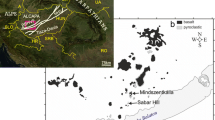Abstract
Reaction textures, fluid inclusions, and metasomatic zoning coupled with thermodynamic calculations have allowed us to estimate the conditions under which a biotite–hornblende gneiss from the Kurunegala district, Sri Lanka [hornblende (NMg=38–42) + biotite (NMg=42–44) + plagioclase + quartz + K-feldspar + ilmenite + magnetite] was transformed into patches of charnockite along shear zones and foliation planes. Primary fluid inclusion data suggest that two immiscible fluids, an alkalic supercritical brine and almost pure CO2, coexisted during the charnockitisation event and subsequent post-peak metamorphic evolution of the charnockite. These metasomatic fluids migrated through the amphibolite gneiss along shear zones and into the wallrock under peak metamorphic conditions of 700–750 °C, 5–6 kbar, and afl H2O=0.52–0.59. This resulted in the formation of charnockite patches containing the assemblage orthopyroxene (NMg=45–48) + K-feldspar (Or70–80) + quartz + plagioclase (An28) in addition to K-feldspar microveins along quartz and plagioclase grain boundaries. Remnants of the CO2-rich fluid were trapped as separate fluid inclusions. The charnockite patches show the following metasomatic zonation patterns:
– a transition zone with the assemblage biotite (NMg= 49–51) + hornblende (NMg = 47–50) + plagioclase + quartz + K-feldspar + ilmenite + magnetite;
– a KPQ (K-feldspar–plagioclase–quartz) zone with the assemblage K-feldspar + plagioclase + orthopyroxene (NMg=45–48) + quartz + ilmenite + magnetite;
– a charnockite core with the assemblage K-feldspar + plagioclase + orthopyroxene (NMg = 39–41) + biotite (NMg=48–52) + quartz + ilmenite + magnetite.
Systematic changes in the bulk chemistry and mineralogy across the four zones suggest that along with metasomatic transformation, this process may have been complicated by partial melting in the charnockite core. This melting would have been coeval with metasomatic processes on the periphery of the charnockite patch. There is also good evidence in the charnockitic core that a second mineral assemblage, consisting of orthopyroxene (NMg= 36–42) + biotite (NMg=50–51) + K-feldspar (Or70–80) + quartz + plagioclase (An28–26), could have crystallised from a partial melt during cooling from 720 to 660 °C at decreasing afl H2O from 0.67 to 0.5. Post-magmatic evolution of charnockite at T < 700 °C resulted in fluids being released during the crystallisation of the charnockitic core. These gave rise to the formation of late stage rim myrmekites along K-feldspar grain boundaries as well as late stage biotite, cummingtonite, and carbonates.
Similar content being viewed by others
Author information
Authors and Affiliations
Additional information
Received: 15 September 1999 / Accepted: 8 June 2000
Rights and permissions
About this article
Cite this article
Perchuk, L., Safonov, O., Gerya, T. et al. Mobility of components in metasomatic transformation and partial melting of gneisses: an example from Sri Lanka. Contrib Mineral Petrol 140, 212–232 (2000). https://doi.org/10.1007/s004100000178
Issue Date:
DOI: https://doi.org/10.1007/s004100000178




